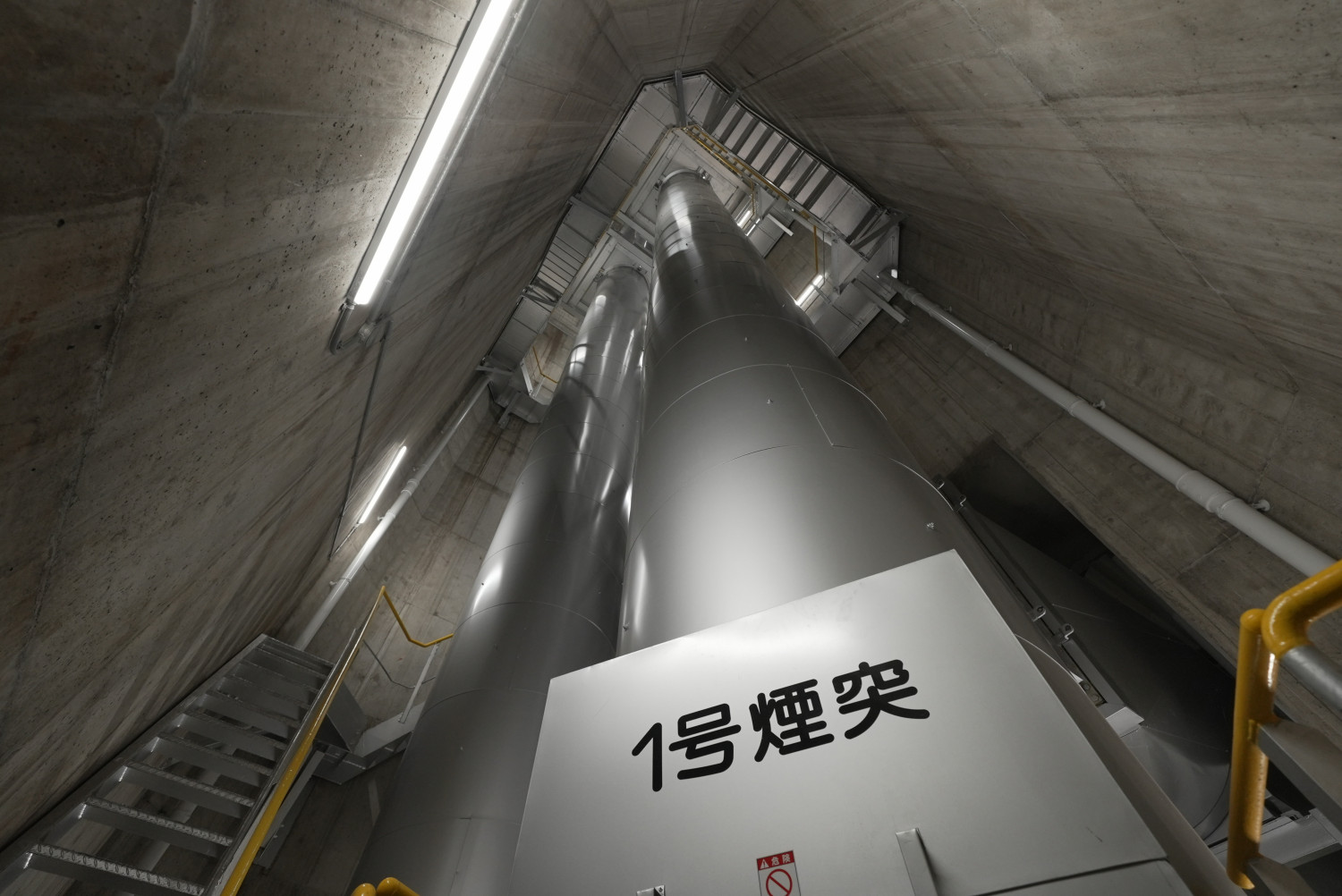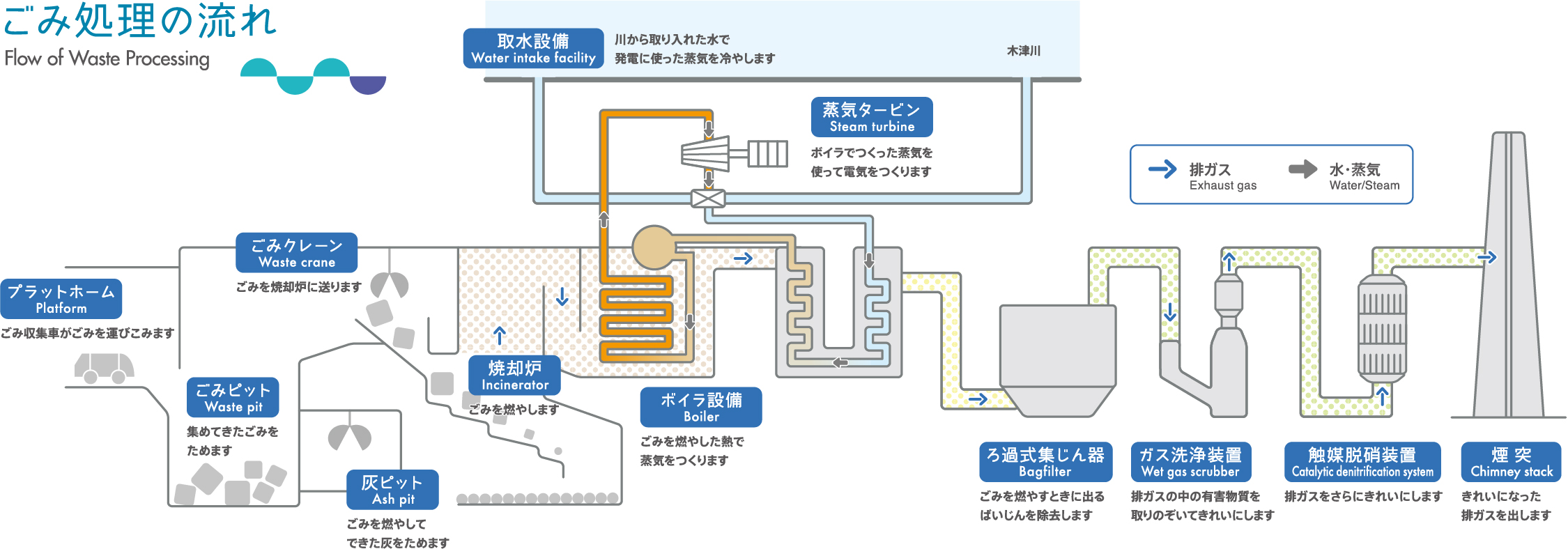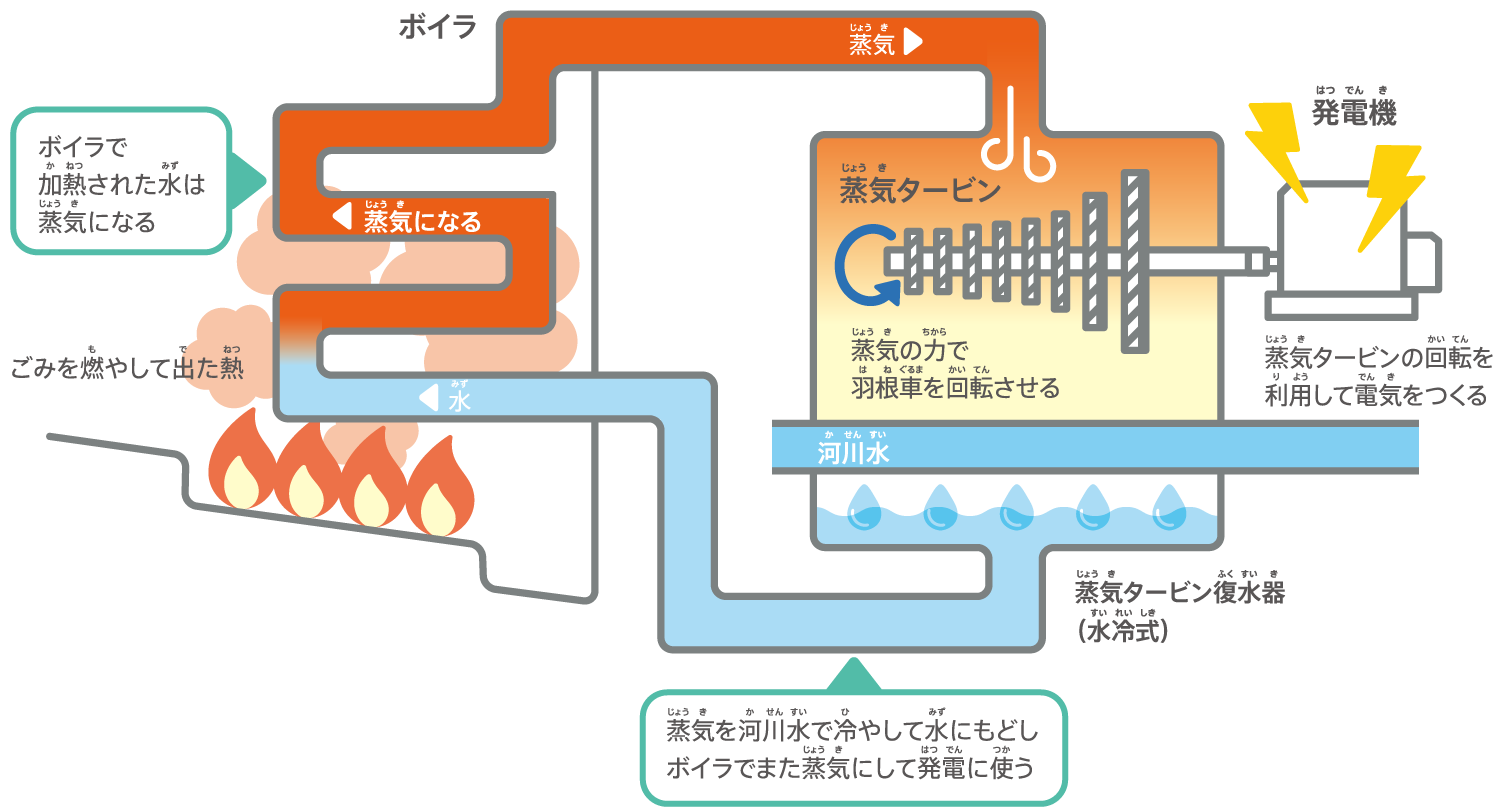ABOUT
施設紹介
- TOP
- 施設紹介

- 施設名称
- 大阪広域環境施設組合 住之江工場
- 所在地
- 大阪府大阪市住之江区北加賀屋4-1-26
- 敷地面積
- 約32,164.31 ㎡(河川区域面積は除く)
- 竣工
- 令和5年3月
- 運営期間
- 令和5年4月1日~令和25年3月31日
- 処理能力
- 400 t /日(200 t /日 × 2炉)
- 焼却炉形式
- 全連続燃焼式(ストーカ式)
- 余熱利用設備
- 蒸気タービン発電機(11,300 kW)
- 設計・施工
- タクマ・鴻池特定建設工事共同企業体
- 運営事業者
- 住之江ハイトラスト株式会社
※本工場は津波・洪水時の津波避難ビルに指定されております。
処理工程
各処理工程で、高度なシステムを駆使し、確実に焼却します。

- Waste loading
- Collected waste is loaded into the waste pit from the waste pit doors on the platform. Through remote operation of the crane from the waste crane control room, the waste held in the waste pit is evenly mixed, and then carried to an opening for waste dumping connected to the incinerator.
ごみの搬入
収集してきたごみは、プラットホームにある投入扉からごみピットに投入します。ごみクレーン操作室では、クレーンの遠隔操作により、ごみピットに貯留されたごみをかき混ぜて均一化したのち、焼却炉につながる投入口まで運びます。
- Incineration
- The incinerator is equipped with a drying stoker, combustion stoker, and burn-out stoker, and each stoker consists of a fixed combustion grate and a movable combustion grate that moves back and forth. Waste loaded into the waste feeding hopper is dried in the drying stoker, combusted in the combustion stoker, and then completely reduced to ash in the burn-out stoker. Temperatures inside the incinerator reach 850°C in order to prevent generation of toxic substances.
焼却
焼却炉には、乾燥ストーカ、 燃焼 ストーカ、後燃焼ストーカが設置され、 各ストーカは固定火格子と往復運動 する可動火格子で構成されています。 投入ホッパに投入されたごみは、乾燥 ストーカで乾燥したのち、 燃焼ストーカ で燃焼、後燃焼ストーカで完全に灰 となります。 約850°Cの高温燃焼により有害 物質の発生を抑制しています。
- Incinerated ash
- Incinerated ash falls onto a water-sealed ash conveyor, is cooled and then sent to the ash pit. Ash temporarily held in the ash pit is loaded onto trucks by the ash crane, and carried to a landfill site.
焼却灰
焼却灰は、水封された灰出しコン ベア上に落下し、冷却され、灰ピットに 送られます。 灰ピットに一時貯留された灰は、 灰クレーンでトラックに積み込まれ、 埋め立て処分地まで運ばれます。
- Air supply
- Air containing odors in the waste pit is supplied to the incinerator, via a forced draft fan, as air for waste combustion.
空気の供給
ごみピット内の臭気を含んだ空気 は、押込送風機により、 ごみの燃焼用 空気として焼却炉に供給します。
- Exhaust gas and waste water treatment
- Heat is absorbed in the boiler, and temperature of the exhaust gas falls to 170-180°C. After blowing in chemicals, dust is removed with a bagfilter. In addition, hydrogen chloride and sulfur oxides are removed with a wet gas scrubber. Nitrogen oxides are broken down with catalytic denitrification systems. Also, waste water produced in the plant is treated with coagulating sedimentation and filtration in waste water treatment equipment, and released into the sewer system or reused in the plant.
排ガス・排水の処理
ボイラで熱を吸収し、 170~180°C に降温した排ガスは、薬剤を吹き込ん だのち、ろ過式集じん器でばいじんを 取り除きます。さらにガス洗浄装置で 塩化水素及び硫黄酸化物を除去し ます。窒素酸化物は、触媒脱硝装置で 分解します。 また、工場内で発生する排水は、 排水処理設備で凝集沈殿及びろ過を 行い、下水道に放流するほか、工場内 で再利用しています。
- Surplus heat usage
- The full amount of steam produced in the boiler, except for the portion used on site, is used for steam turbine electric power generation, and this provides all of the plant's electricity. Excess electricity is transmitted to power companies, etc.
余熱の利用
ボイラで発生した蒸気は、 所内利用 を除く全量を蒸気タービン発電に 利用し、工場内のすべての電気をまか なっています。さらに余った電気は 電力会社などに送電しています。
発電量等の紹介
ごみを燃やすときに出る熱を利用して
電気をつくっています。
- 令和7年11月の発電量
- 4,235,300 kWh

ごみを燃やすときにできた熱は、ボイラの中の水を蒸気に変えます。
この蒸気が「蒸気タービン」に流れこみ、大きな羽根車を高速で回転させ、
その回転を「発電機」に伝えて電気をつくっています。
蒸気タービンでつくられた電気は、住之江工場で使うほか、あまった分は電力会社に売っています。
